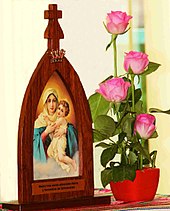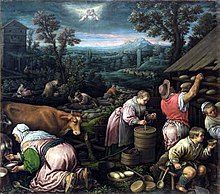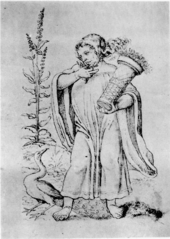May
![]()
The title of this article is ambiguous. For other meanings, see May (disambiguation).
May (from Middle High German meie: the month 'May', also 'spring') is the fifth month of the year in the Gregorian calendar. It has 31 days.
This month is named - so the testimonies of a number of Latin authors - after the Roman goddess Maia, to whom the Fleming Volcanalis offered a sacrifice on the first day of this month. The origin of the equation of this - according to Gellius - anciently venerated goddess "Maia Vulcani" (probably to be thought as "wife of Vulcanus") with the goddess Bona Dea and Terra - according to Macrobius - or a Pleiad and the mother of Hermes/Mercurius is unclear; but the etymological assignment to the word root *mag (and thus to growth and multiplication) is regarded as certain. This places the mensis Maius in the original Roman peasant year. Macrobius knows of a god "Maius, qui est Iuppiter" who was worshipped only locally. During the reign of Emperor Nero the month was renamed Claudius, one of the emperor's names, but it did not catch on. Under the emperor Commodus the month was then called Lucius, again one of his names, this renaming was also reversed after the emperor's death.
In the pre-Julian Roman calendar the Maius was the third month, in the Julian calendar the fifth, both with 31 days.
In the Catholic church year, May is especially dedicated to the veneration of Mary, the Mother of God (Marian customs in May), which is why it is also called the Marian Moon in this context.
May begins with the same day of the week as January of the following year, but no other month of the same year begins with the same day of the week as May.
The first of May is the international holiday (in Germany: public holiday) of the workers' movement. The second Sunday in May is Mother's Day in German-speaking countries.
Charlemagne introduced the name Wonnemond (actually Old High German "wunnimanot" = pasture month) in the 8th century, which refers to the fact that cattle could be driven out to pasture again in this month. So the old name of the month has nothing to do with "delight" in today's context. But this misunderstanding can be found already at the beginning of modern times and New High German. According to the German Dictionary of the Brothers Grimm s. v. WONNEMONAT Basilius Faber explains in 1587 [sic!]: "maius, der may, a frondibus Carolus Magnus den wonnemonat, id est mensem amoenitatis olim nuncupavit" ("maius, der may, after the foliage once Charlemagne named the wonnemonat, i. e. the month of loveliness"). Likewise, May received the name flower moon because of the main flowering time of most plants. According to old tradition, one can only be sure of the increasing warmth after the so-called Ice Saints from May 11 to May 15. May has been celebrated in Europe since around the 13th century with May festivals, May walks and May rides, and in many parts of Germany and Austria the erection of often imposing May trees is a long-established custom; festivals such as Beltane or Walpurgis Night have existed for longer.

May Tartar in Honor of Mary

May , Leandro Bassano

The month of May in the chronograph of 354 by the late antique calligrapher Filocalus.
See also
- Floating holidays | Floating memorial days
- Historical Anniversaries | Time Scale
- Weather and farming rules for May
Questions and Answers
Q: What is the fifth month of the year?
A: May is the fifth month of the year in both the Julian and Gregorian calendars.
Q: How many days are there in May?
A: May has 31 days.
Q: Who might have been responsible for naming the month of May?
A: The month of May may have been named after either Roman goddess Maia or more likely Bona Dea, whose festival was held in this month.
Q: Does May ever begin or end on the same day as any other month?
A: No, it does not; May never begins or ends on the same day as any other month.
Q: What flower is associated with May?
A: The flower associated with May is Lily of the Valley.
Q: What is its birthstone?
A: The birthstone for May is emerald.
Q: What does an emerald symbolize?
A: An emerald symbolizes success in love.
Search within the encyclopedia